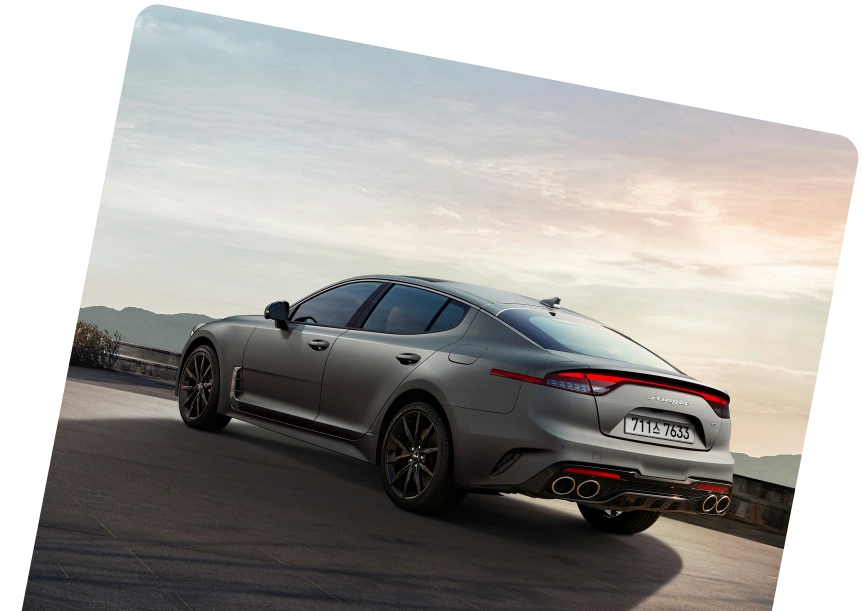
Family SUVs are everywhere these days, but the Nissan Qashqai and Ford Kuga remain two of the most popular choices, and it’s easy to see why. Both have sensible sizes, large enough for a family but not so big that they cannot fit down a narrow street. Both provide a soft ride, and both come at reasonable prices, especially as used cars.
But which one should you buy?
Quick Overview
Take a look at how the Kuga and Qashqai stack up across key areas:
| Ford Kuga | Nissan Qashqai |
Dimensions | 4,614 x 1,882 x 1,689 mm | 4,394 x 1,806 x 1,590 mm |
Horsepower | 120-243hp | 140-190hp |
0-60 mph | 8.7 seconds | 9 seconds |
Seats | 5 | 5 |
Fuel options | Petrol, diesel, hybrid, PHEV | Petrol, diesel, mild hybrid |
Gearbox options | Manual, auto | Manual, auto |
Boot space | 526L (up to 1,534L) | 504L (up to 1,447L) |
Insurance group | 14-34 | 13-30 |
Price Comparison
When it comes to new cars, the Kuga costs between £33,000 and £43,000, depending on the trim. The Qashqai comes in slightly lower, starting around £31,000 and reaching up to £39,000 for higher-end models.
On the used market, both SUVs are more accessible. A used Ford Kuga from 2018 with around 50,000 miles typically sells for around £10,000 and up, and a similarly-aged used Nissan Qashqai generally starts at around £8,000 to £10,000.
Engine Options
The Ford Kuga offers several engine options. Petrol engines start with a 1.5-litre EcoBoost, paired with a six-speed manual gearbox, and diesel models provide a practical option for longer journeys. Hybrid and plug-in hybrid options expand the range further. The full-hybrid 2.5 FHEV comes with a CVT automatic and can cover short distances on electric power alone. The PHEV version adds a longer electric-only range of up to 43 miles and a higher towing capacity.
The Qashqai keeps its engine options straightforward but capable. The entry-level 1.3 DIG-T 140 mild-hybrid petrol balances efficiency and usable power. A slightly stronger 156 bhp version adds four-wheel-drive capability for those who need it. The e-Power uses a 1.5-litre petrol engine to charge a battery that drives an electric motor.
Fuel Economy
The Kuga delivers fuel consumption that fits well with family life and longer journeys. Across the range, drivers can expect roughly 41-53 mpg, withfuel efficiency varying by drivetrain and trim.
The Nissan Qashqai counters that with slightly more consistent efficiency, returning around 45-50 mpg across its petrol models.
The hybrid versions stretch that further, as the self-charging and plug-in hybrid systems maximise fuel economy. The Ford Kuga’s PHEV offers an official combined WLTP figure of 201.8 mpg. The Qashqai e-Power also makes a smart choice for families, with an official 62.8 mpg and a range of up to 759 miles between fill-ups.
Performance
The Ford Kuga feels confident on all types of roads. Behind the wheel, the steering offers precision and control both in the city and on the motorway. On twisty B-roads, the Kuga holds the line well with minimal body roll, and the suspension softens bumps to keep passengers comfortable even on rough surfaces.
ST-Line trims add a firmer setup that stabilises the car at higher speeds. Long trips are easier thanks to the well-insulated cabin and adaptive cruise control, which maintain a quiet environment and reduce fatigue.
The Qashqai’s driving experience feels calm and well-balanced. Similar to the Kuga, the suspension ensures a comfortable ride on uneven roads. The light steering makes manoeuvres in tight spaces straightforward, though the car feels less agile on sharper corners than the Kuga. On motorways,higher trims with ProPILOT combine lane assistance and adaptive cruise control.
Interior
The Kuga provides a practical and functional cabin with plenty of space for both passengers and luggage. The front seats offer solid support on longer journeys, and those in the back benefit from generous legroom and headroom.
The materials combine soft-touch surfaces with harder plastics, though higher trims improve the feel with stitched upholstery and subtle ambient lighting. The dashboard layout is clear, and physical controls for climate and audio are easy to operate on the move. Storage is well considered, with cupholders, door pockets, and a flexible rear seat arrangement that addsversatility for family use.
The Qashqai feels a little more refined, with soft-touch surfaces across the dash and doors and neat stitch lines that give a premium impression. Still, the layout appears toprioritise function, too.
The front seats are comfortable even on long drives, and the cabin layout places all key controls within easy reach. Rear passengers have adequate space, although taller adults may findrear legroom slightly tighter than in the Kuga. The storage compartments are practical, and higher trims provide a clear infotainment screen with smartphone integration and app support.
Boot Space
The Ford Kuga has a boot that feels genuinely generous and versatile. With a capacity of 526 litres, it handles suitcases, shopping, and sports gear with ease. When the rear seats are folded, the Kuga offers up to 1,534 litres. Overall, the boot brings togetherstyle and space.
The flat rear floor allows larger items to fit without awkward adjustments. The wide opening and low lift-over height make loading simple, and the shape of the space allows you to stack bags or boxes neatly.
The Qashqai has a slightly smaller boot capacity at 504 litres, but it still offers practical storage for everyday life.
The flat floor and well-shaped space allow weekend luggage or grocery runs to fit comfortably. The wide access to the Qashqai’s boot helps with larger items, and the layout keeps everything within reach, with up to 1,447 litres with the rear seats folded.
Technology
The Kuga provides practical technology for everyday use. Its SYNC 3 infotainment system features an 8-inch touchscreen with Apple CarPlay and Android Auto, which make navigation and media simple to access. Higher trims add a digital driver display and a premium audio system. Parking sensors and adaptive headlight technology also help make the Kuga easier to park and safer to drive at night.
The Qashqai offers a slightly more advanced setup with its 12.3-inch touchscreen and NissanConnect system, which includes navigation, app integration, and smartphone connectivity. Top trims add a head-up display and a premium Bose audio system. Also, a Qashqai’sdigital instrument cluster helps you feel more in control and aware of what’s happening as you drive.
Safety & Reliability
The Ford Kuga has a strong reputation for reliability. Its engines and systems have proven durable over time, and routine maintenance remains straightforward. Replacement parts are easy to find, which helps keep ownership manageable.Euro NCAP crash test results show a well-built structure and thoughtfully placed safety features that protect adults and children alike.
The Nissan Qashqai also earns praise for reliability. Its petrol and mild-hybrid engines perform consistently across multiple model years, and electrical systems show few widespread issues. Servicing is simple, and parts are widely available. Safety tests reflect a dependable design that protects occupants in various scenarios, offering similarpeace of mind for everyday driving.
Insurance Costs
Both fall into accessible groups for mid-sized SUVs. The Ford Kuga sits in insurance groups 14 to 34. On average, annual insurance for a Kuga is around £713, though location, age, and driving history can affect the final cost.
The Qashqai has slightly lower insurance groups, from 13 to 30, which usually results in a modestly cheaper premium. The average annual cost is around £685, but this can change, too.
Running Costs
The Kuga and Qashqai both deliver reasonable running costs, though there are some differences worth noting. The Kuga offers fuel economy of around 41 to 53 mpg, depending on engine and trim. The Qashqai achieves roughly 45 to 50 mpg. Diesel and hybrid models in both ranges keep fuel expenses lower, especially for drivers who cover longer distances.
Road tax starts at about £195 per year for both vehicles. Maintenance and servicing are generally in line with other cars in this category, though hybrid andplug-in hybrid versions have slightly higher servicing needs.
How Carplus Helps You Finance the Car You Want
At Carplus, we help you get the car you want with flexible finance options, often without a deposit. Our wide panel of UK car lenders provides access to deals that fit your budget and circumstances, including options for those with less-than-perfect credit.
You can secure a reliable SUV from trusted dealerships and join the many customers who have turned to us for their car finance needs. See what Carplus can do for you!
Best Choice for First-Time Buyers
The Nissan Qashqai works well for first-time buyers because it offers comfort, practicality, and a sensible list price. Its size makes city parking easy, and the suspension keeps the ride smooth over uneven roads. The cabin feels carefully designed, with clear controls and an infotainment system that is easy to use.
Best Choice for Experienced Buyers
The Ford Kuga suits experienced drivers who want a more engaging drive and extra space. Its steering responds well, and the car stays composed on twisty roads, which gives a more dynamic feel than the Qashqai. Theinterior and boot space are both generous.
Verdict
After looking at all the details, both the Ford Kuga and Nissan Qashqai show strong qualities in design, performance, and practicality. The choice comes down to which aspects matter most: a car that feels sporty and enjoyable to drive, or one that offers a more relaxed and spacious experience.
Both models are reliable, well-rounded options in the mid-sized SUV segment. Ultimately, it comes down to which one feels like the best fit for you and the way you drive every day.
Table of Contents








